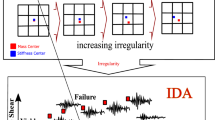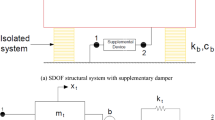Abstract
A number of studies have been carried out to investigate the performance of viscoelastic dampers (VEDs) and magnetorheological dampers (MRDs) in controlling the seismic response of buildings, but very few of them regarding the effect of temperature on the behavior of those dampers. The energy absorption properties of the VEDs are dependent on the ambient temperature, excitation frequency and strain amplitude. Several mathematical models have been investigated for reproducing the experimental behavior of single degree of freedom VEDs and MEDs. Of these, only the fractional derivative model can reflect the influence of temperature which is, however, so complex that it is difficult to apply in structural analysis. In order to verify the effect of temperature, two case studies of structural element have been conducted: once using VED and once using MRD. Kelvin–Voigt mathematical model applied, they were investigated and after analyzing the results, the force vs. displacement showed that MRD achieved a high force capacity and a better performance than VED. Furthermore, the effect of the temperature in case of VED observed via plotting the dissipated energy hysteresis at different temperatures. These results validate the effect of the temperature as the lower the temperature the more viscous the dashpot element becomes, hence improving damping, but this is up to a specific low temperature.












Similar content being viewed by others
References
Balevicius, R.: An average stress strain approach to creep analysis of RC uncracked elements. Mech. Time-Depend. Mater. 14, 69–89 (2010)
Bhatti, A.Q., Kishi, N.: Impact response of RC rock-shed girder with sand cushion under falling load. Nucl. Eng. Des. 240(10), 2626–2632 (2010)
Bhatti, A.Q., Kishi, N.: Impact response analysis of prototype RC girders with sand cushion using equivalent fracture energy concept. Int. J. Damage Mech. 20(7), 1094–1111 (2011a)
Bhatti, A.Q., Kishi, N.: An application of impact–response analysis on small-scale RC arch-type beams without stirrups. Constr. Build. Mater. 25(10), 3972–3976 (2011b)
Bhatti, A.Q., Kishi, N.: Applicability of the impact response analysis method for Reinforced Concrete (RC) beams mixed with Poly Vinyl Alcohol (PVA) short fibers. Int. Polym. Process. 26(5), 470–477 (2011c)
Bhatti, A.Q., Kishi, N.: Control of FRP debonding in strengthened RC beams. Arab. J. Sci. Eng. (2012). doi:10.1007%2Fs13369-012-0304-4
Bhatti, A.Q., Kishi, N., Mikami, H., Ando, T.: Elasto-plastic impact–response analysis of shear-failure type RC beams with shear rebars. Mater. Des. 30(2), 502–510 (2009)
Bhatti, A.Q., Zamir, S., Rafi, Z., Ali, Q., Zubaida, K.: Seismic hazard analysis of Islamabad. J. Asian Earth Sci. 42(3), 468–478 (2011a)
Bhatti, A.Q., Kishi, N., Tan, K.H.: Impact resistant behaviour of an RC slab strengthened with FRP sheet. Mater. Struct. 44(10), 1855–1864 (2011b). doi:10.1617/s11527-010-9621-9
Bhatti, A.Q., Shameem, K., Aamir, M., Abid, D., Kishi, N.: Numerical study for impact resistant design of full scale arch type reinforced concrete structures under falling weight impact test. J. Vib. Control 18(9), 1275–1283 (2012a). doi:10.1177/1077546311419176
Bhatti, A.Q., Kishi, N., Konno, H., Mikami, H.: Elasto-plastic dynamic response analysis of prototype RC girder under falling-weight impact loading considering mesh size effect. Struct. Infrastruct. Eng. Maint. Manag. Life-Cycle Des. Perform. 8(9), 817–827 (2012b)
Datta, T.K.: Seismic Analysis of Structures. Wiley, New York (2010). ISBN 978-0-470-82461-0
Dixon, J.C.: The Shock Absorber Handbook, 1st edn. Wiley, New York (1999). ISBN-10 0768000505
Kishi, N., Bhatti, A.Q.: An equivalent fracture energy concept for nonlinear dynamic response analysis of prototype RC girders subjected to falling-weight impact loading. Int. J. Impact Eng. 37(1), 103–113 (2010)
Lagarde, A.: IUTAM Symposium on Advanced Optical Methods and Applications in Solid Mechanics, 1st edn. Springer, Berlin (2000). 266 p., ISBN-10 0792366042
Lee, S.-H., Son, D.-I., Kim, J., Min, K.-W.: Optimal design of viscoelastic dampers using eigenvalue assignment. Earthquake Eng. Struct. Dyn. 33, 521–542 (2004). doi:10.1002/eqe.364
Symans, M.D., Constantinou, M.C.: Semi-active control systems for seismic protection of structures: a state-of-the-art review. Eng. Struct. 21(6), 469–487 (1999). doi:10.1016/S0141-0296(97)00225-3, ISSN 0141-0296
Xu, Z.-D.: Earthquake mitigation study on viscoelastic dampers for reinforced concrete structures. J. Vib. Control 13, 29–43 (2007). doi:10.1177/1077546306068058
Author information
Authors and Affiliations
Corresponding author
Rights and permissions
About this article
Cite this article
Bhatti, A.Q. Performance of viscoelastic dampers (VED) under various temperatures and application of magnetorheological dampers (MRD) for seismic control of structures. Mech Time-Depend Mater 17, 275–284 (2013). https://doi.org/10.1007/s11043-012-9180-2
Received:
Accepted:
Published:
Issue Date:
DOI: https://doi.org/10.1007/s11043-012-9180-2




